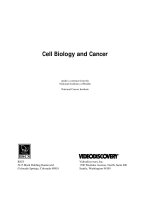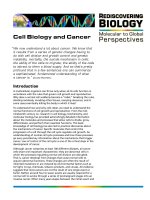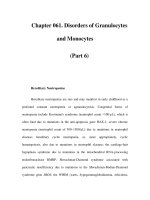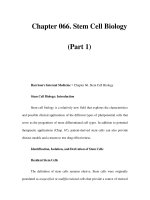Chapter 080. Cancer Cell Biology and Angiogenesis (Part 18) doc
Bạn đang xem bản rút gọn của tài liệu. Xem và tải ngay bản đầy đủ của tài liệu tại đây (14.8 KB, 5 trang )
Chapter 080. Cancer Cell Biology
and Angiogenesis
(Part 18)
Antiangiogenic Therapy
Understanding the molecular mechanisms that regulate tumor angiogenesis
may provide unique opportunities for cancer treatment. Acquired drug resistance
of tumor cells due to their high intrinsic mutation rate is a major cause of
treatment failure in human cancers. ECs comprising the tumor vasculature are
genetically stable and do not share genetic changes with tumor cells; the EC
apoptosis pathways are therefore intact. Each EC of a tumor vessel helps provide
nourishment to many tumor cells, and although tumor angiogenesis can be driven
by a number of exogenous proangiogenic stimuli, experimental data indicate that
at least in some tumor types, blockade of a single growth factor (e.g., VEGF) may
inhibit tumor-induced vascular growth. Angiogenesis inhibitors function by
targeting the critical molecular pathways involved in EC proliferation, migration,
and/or survival, many of which are unique to the activated endothelium in tumors.
Inhibition of growth factor and adhesion-dependent signaling pathways can induce
EC apoptosis with concomitant inhibition of tumor growth. Different types of
tumors use distinct molecular mechanisms to activate the angiogenic switch.
Therefore, it is doubtful that a single antiangiogenic strategy will suffice for all
human cancers; rather, a number of agents will be needed, each responding to
distinct programs of angiogenesis used by different human cancers.
Four randomized phase III clinical trials have demonstrated that the
addition of bevacizumab (Avastin; a humanized monoclonal antibody that binds
and inhibits VEGF) to chemotherapy results in significantly improved response
rates, progression-free survival, and overall survival when compared to treatment
with chemotherapy alone (Table 80-3). This effect was shown in the first-line
treatment of patients with advanced colon, lung, and breast cancers, and in the
second-line treatment of colon cancer. However, not all trials have been positive;
in previously treated breast cancer, the addition of bevacizumab to capecitabine
(an oral fluoropyrimidine) did not increase efficacy, and in previously untreated
pancreatic cancer, bevacizumab did not enhance the efficacy of gemcitabine.
Table 80-3 Randomized Phas
e III Clinical Trials Demonstrating the
Efficacy of Bevacizumab in Combination with Chemotherapy for the
Treatment of Advanced Cancers
Tu
mor Type
Stage
of Disease
Previ
ous
Treatment
Num
ber of
Patients
Chemothe
rapy Regimen
Outc
ome
Col
on cancer
Metas
tatic
No 813 Irinotecan
+ 5-
FU/LV ±
bevacizumab
Incre
ased OS
(20.3 vs 15.6
months),
PFS (10.6 vs
6.2 months),
and RR
(44.8 vs
34.8%)
Col
on cancer
Metas
tatic
Seco
nd line;
previous
irinotecan/5
-FU
829 FOLFOX
± bevacizumab
Incre
ased OS
(12.9 vs 10.8
months),
PFS
(7.2 vs
4.8 months),
RR (21.8 vs
9.2%).
Non
-
small cell
lung
cancer
(excluding
squamous
histology)
Metas
tatic
No 878 Carboplati
num + paclitaxel
± bevacizumab
Incre
ased OS
(12.5 vs 10.2
months),
PFS (6.4 vs
4.5 months),
RR (27.2 vs
10.0%).
Bre
ast cancer
Recur
rent or
metastatic
No 722 Paclitaxel
± bevacizumab
Incre
ased PFS
(11.0 vs 6.2
months), RR
(28 vs 14%).
Note: 5-FU, 5-
fluorouracil; LV, leucovoran; OS, overall survival; PFS,
progression-free survival; RR, response rate; FOLFOX, folinic acid (LV), 5-
FU,
and oxaliplatinum.









